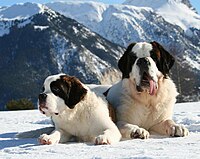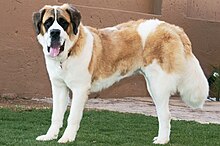St. Bernard
Lifespan: 8 – 10 y
Mass: 64 – 120 kg
Height: 70 – 90 cm (At the withers)
Temperament: Lively, Watchful, Gentle, Friendly, Calm
Colors: Reddish-brown Brindle, Reddish-brown Splash, Reddish-brown Mantle, Brownish-yellow, Red & White
Appearance
The St. Bernard is a giant dog. The average weight of the breed is between 140 and 264 lb (64–120 kg) or more and the approximate height at the withersis 27½ inches to 35½ inches (70 to 90 cm).[1] The coat can be either smooth or rough, with the smooth coat close and flat. The rough coat is dense but flat, and more profuse around the neck and legs. The coat is typically a red color with white, or sometimes a mahogany brindle with white. Black shading is usually found on the face and ears. The tail is long and heavy, hanging low eyes should have naturally tight lids, with "haws only slightly visible". The eyes are usually brown, but sometimes can be icy blue.
History
The ancestors of the St. Bernard share a history with the Sennenhunds, also called Swiss Mountain Dogs or Swiss Cattle Dogs, the large farm dogs of the farmers and dairymen of the livestock guardians, herding dogs, anddraft dogs as well as hunting dogs, search and rescue dogs, and watchdogs. These dogs are thought to be descendants of molosser type dogs brought into the Alps by the ancient Romans, and the St. Bernard is recognized internationally today as one of the Molossoid breeds.[2]
The earliest written records of the St. Bernard breed are from monks at the hospice at the Great St Bernard Pass in 1707, with paintings and drawings of the dog dating even earlier.[3]
The most famous St. Bernard to save people at the pass was Barry (sometimes spelled Berry), who reportedly saved somewhere between 40 and 100 lives. There is a monument to Barry in the Cimetière des Chiens, and his body was preserved in the Natural History Museum in Berne.[4]
The classic St. Bernard looked very different from the St. Bernard of today because of cross-breeding. Severe winters from 1816 to 1818 led to increased numbers of avalanches, killing many of the dogs used for breeding while they were performing rescues.[5][6] In an attempt to preserve the breed, the remaining St. Bernards were crossed with Newfoundlands brought from the Colony of Newfoundland in the 1850s, and so lost much of their use as rescue dogs in the snowy climate of the alps because the long fur they inherited would freeze and weigh them down.[7]
The dogs never received any special training from the monks. Instead, younger dogs would learn how to perform search and rescue operations from older dogs.[8]
The Swiss St. Bernard Club was founded in Basel on March 15, 1884. The St. Bernard was the very first breed entered into the Swiss Stud Book in 1884, and the breed standard was finally approved in 1888. Since then, the breed has been a Swiss national dog.[3]
Naming
The name "St. Bernard" originates from the Great St Bernard Hospice, a traveler's hospice on the often treacherous St. Bernard Pass in the Western Alpsbetween Switzerland and Italy. The pass, the lodge, and the dogs are named for Bernard of Menthon, the 11th century monk who established the station.[9]
"St. Bernard" wasn't in widespread use until the middle of the 19th century. The dogs were called "Saint Dogs", "Noble Steeds", "Alpenmastiff", or "Barry Dogs" before that time.
Related breeds
The breed is strikingly similar to the English Mastiff and Newfoundland. This can be attributed to a common shared ancestry with the Alpine Mastiff and the Tibetan Mastiff. It is suspected that these breeds were used to redevelop each other to combat the threat of their extinction after World War II.[10]
The four Sennenhund breeds, the Grosser Schweizer Sennenhund (Greater Swiss Mountain Dog), the Berner Sennenhund, (Bernese Mountain Dog), theAppenzeller Sennenhund, (Appenzeller), and the Entlebucher Sennenhund (Entlebucher Mountain Dog) are similar in appearance and share the same location and history, but are tricolor rather than red and white.
St. Bernards share many characteristics of many Mountain dog breeds.
Kennel Club recognition
The St. Bernard is recognised internationally by the Fédération Cynologique Internationale as a Molosser in Group 2, Section 2. The breed is recognised by The Kennel Club (UK), the Canadian Kennel Club, and the American Kennel Club in the Working Dog breed group. The United Kennel Club (US) places the breed in the Guardian Dog Group. The New Zealand Kennel Club and theAustralian National Kennel Council place the breed in the Utility Group
Modern activities - Great St Bernard Pass
Main articles: Great St Bernard Pass and Great St Bernard Hospice
St. Bernard dogs are no longer used for Alpine rescues, the last recorded instance of which was in 1955. As late as 2004, the Great St Bernard Hospice still maintained 18 of the dogs for reasons of tradition and sentiment. In that year the Barry Foundation created breeding kennels for the breed at the town of Martigny down the Pass, and purchased the remaining dogs from the Hospice.
The animals bred by the Foundation are trained to participate in a variety of dog sports including carting and weight pulling. The dogs at the Barry Foundation are reportedly smaller than the average St Bernard.[citation needed]
Health
The very fast growth rate and the weight of a St. Bernard can lead to very serious deterioration of the bones if the dog does not get proper food and exercise. Many dogs are genetically affected by hip dysplasia or elbow dysplasia. Osteosarcoma (bone cancer) has been shown to be hereditary in the breed.[11] They are susceptible to eye disorders called entropion and ectropion, in which the eyelid turns in or out. The breed standard indicates that this is a major fault. The breed is also susceptible to epilepsy and seizures, a heart disease called dilated cardiomyopathy, and eczema.
US and UK breed clubs put the average lifespan for a St. Bernard at 8–10 years.[12][13][14] A 2003 Danish breed survey (35 dogs) puts the median lifespan at 9.5 years while a UK breed survey in 2004 (53 dogs) puts the median lifespan at 7 years. In the UK survey about one in five lived to >10 years with the longest lived dog at 12 years and 9 months.[15][16]
Temperament
St. Bernards, like all very large dogs, must be well socialized with people and other dogs in order to prevent fearfulness and any possible aggression or territoriality. The biggest threat to small children is being knocked over by this breed's larger size. Overall they are a loyal and affectionate breed, and if socialized are very friendly. Because of its large adult size, it is essential that proper training and socialization begin while the St. Bernard is still a puppy, so as to avoid the difficulties that normally accompany training large dogs. An unruly St. Bernard may present problems for even a strong adult, so control needs to be asserted from the beginning of the dog's training. While generally not as aggressive as dogs bred for protection, a St. Bernard may bark at strangers, and their size makes them good deterrents against possible intruders.[17][18]
Notability
Record size
St. Bernards were exported to England in the mid-19th century, where they were bred with mastiffs to create an even larger dog. Plinlimmon, a famous St. Bernard of the time, was measured at 95 kg (210 lbs) and 87.5 cm (341⁄2ins), and was sold to an American for $7000.[9] Commercial pressure encouraged breeding ever larger dogs until "the dogs became so gross that they had difficulties in getting from one end of a show ring to another".[9]
An 1895 New York Times report mentions a St. Bernard named Major F. measuring 8 feet 6 inches (2.59 m) in length, who, if the claims are true, would be the longest dog in history.[19] Another St. Bernard named Benedictine V Schwarzwald Hof (Pierson, Michigan - USA) also reached 315 lb (143 kg), which earned a place in the 1981 edition of the Guinness Book of World Records.[20]










No comments:
Post a Comment